Multi Project Management with Safran Planner
Introduction to Master Projects
Safran Planner provides a wide range of flexible facilities that enable effortless management and control of any number of single projects. Working with a Master Project is like working with a single project.
The Master Project concept is easy to set up and has few limitations. Single Projects may be added or removed anytime, enabling precise resource management.
Multiple Master Projects may be created, and single projects may be added to numerous Master Projects to model various scenarios, enabling efficient Multi-project Resource Management or Project Portfolio Management.
Safran Planner's Master Project concept also lends itself to large-scale development/construction projects where each major contractor plans and controls its project with its attributes and potential cross-project links to activities in other contractors' schedules. This helps support efficient and precise interface planning. At the same time, the project owner uses the Master Project to get insight into the project as a whole and manage and report on its status.
Using each source project's data means that what is seen in a Master Project is always up to date with the latest changes and status information from each source project.
Setting up a Master Project
To set up a Master Project, you should create a new project without any activities that will be considered the Master Project.
After this is established, the various source projects may be added to the Master Project. These projects will be considered as Sub-projects.
Although the Master Project utilises many of each sub-project's attributes and properties, such as the Calendar and Schedule Options, a few attributes must be shared or synchronised across all source projects. These attributes are:
- Calendar
- Userfields
- Resource definitions
- Profiles
- Symbols
A new Master Project may be created by selecting 'New' from the File tab of the ribbon.

When the File Properties panel appears, fill out the relevant initial information.
The Name, Title, and Subject fields, amongst others, are readily available for use on both Barchart and Histogram reports.

Be sure to check out the Timenow date and modify it if necessary, ensuring it is at least the same date as the earliest Timenow amongst the source projects you intend to add to your group. Failing to do so may negatively affect the Live plan dates in one or more of your source projects.
Press OK to create the project, after which the Barchart Editor opens.
Safran Planner allows you to store and work with projects in a master project where the Master Project is either an operating system file or a database entity.
Safran Planner also supports master projects with a combination of projects stored in both files/a database.
Be aware that if your Master Project is a file, it can only contain file-based projects, as a file-based master project cannot establish a database connection and open a sub-project from a database.
To access and add source projects from a database, you must first save the master project to the database.
Select Save from the File tab of the ribbon menu.
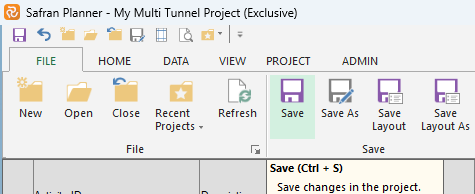
When the Save As panel opens, press OK to save the master project to the database or select Save To File if your projects are file-based.

Once you have created your Master Project, the next step is to ensure that Safran Planner is in Outline View, as shown below. This is a pre-requisite when adding or removing projects from a Master Project.

Adding Projects to a Master Project
To add projects to your master project, right-click on the column area and select Add/Project.
Alternatively, you can find this on the Home/Rows tab of the ribbon menu by expanding the 'Insert' icon.

When the Add Project panel appears, you can search for and select the project to include in the group by pressing Open Project.

Alternatively, press Open from file to access file-based projects, as shown below.

Adding a file-based sub-project
In Outline View, each addition of a sub-project will place the project at the bottom of the list of projects, as shown below.

If you require a different order, you can set focus on a project and select Insert Project so that the new sub-project will be added above the project you have focused on. This sorting of sub-projects is only valid when using the Outline View.
If you switch to Group View, you can sort your projects according to any relevant system/userfield in the usual way by specifying Group Properties.
When establishing a Master Project, you will have sufficient access to add or remove Sub-Projects by default.
If you intend to change an existing Master Project later, open it with Exclusive access.
If you forgot to do so when you opened the master project, you can still select your access level by selecting Access Level from the Data tab of the ribbon menu.

Master Project Properties
Not all of the master project's properties are available for input when the project is initially established.
To access the remaining properties and attributes, select Project Properties from the ribbon menu.

File Properties - Data tab
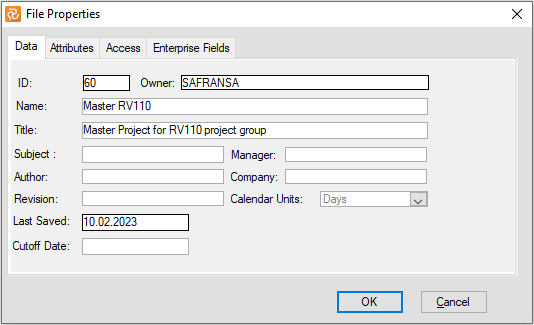
The File Properties/Data tab allows you to configure the Master Project's superficial properties such as Name, Title, Manager, etc. These properties are readily available as Header/Footer information on all Safran Barchart layouts and report configurations.
File Properties - Attributes tab

The three essential Attributes/Information Sets that need to be 'connected/associated' are the Calendar, Userfields configuration and Resource Definitions that the Master Project will utilise.
It is essential to choose a calendar that encompasses the duration of the entire project group if you use Project Month as an interval in your Editor Histogram.
Userfields are used extensively for Group, Sort, and Filter project activities in Barchart Layouts and Report configurations. They must be considered so that at least the userfields you use actively are standardised.
This type of information is often already standardised in larger organisations or produce-to-order environments, so choosing a common Userfields/Resource def. for a Master Project usually is not that difficult.
File Properties - Access tab

Access to the Master Project may be specified on the 'Access' tab using the drag 'n' drop technique. Please select the relevant user and move it to the left to give access to a user. Once the user is placed to the left, select the required Access Level using the Access dropdown. In the same way, you may also give access to a Group of users if User Groups have been defined.
Keep in mind that a user will also have to have access to all or relevant sub-projects at the project level in the Master Project. That access to project activities will be established as a combination of the project and master project accesses.
Consider the following:
A master project consists of four projects: A, B, C, and D. A user is given update access to the Master Project. The user also has update access to Projects A and B, read access to Project C, and no access to Project D.
When the user opens the Master Project, they can update Project A and B activities, activities from Project C, which are only readable, and Project D activities, which are not presented even though the user has Update access to the project group. (The user can see potential 'Interface Activities' from Project D.)
If we consider a similar case where the user has the same access at the project level as discussed above but only has read access at the Master Project level, the resulting access would be read access to projects A, B, and C and no access to project D.
File Properties - Enterprise Fields tab

In the same way as a single Project, Master Projects may also use Enterprise fields to help categorise Master Projects when using the Enterprise Selector. Choose the relevant value for each Enterprise field from the adjacent dropdown.
Selecting projects using the Enterprise selector
If your database contains many projects, using the 'Enterprise Selector might help you locate them.
The enterprise selector allows you to build a tree structure of up to four levels and organise your projects based on each project's Enterprise Codes and values.

To define your Enterprise selector/groups, drop in and choose the enterprise fields you want to group your projects in the 'Top Level/Then' dropdowns. After establishing the structure, you can use the nodes to navigate it. When you select a node, the list of projects in the upper pane will consist of the master projects for that group/node. In 'As Master Project' mode, the lower pane will present the sub-projects for the focused Master Project.
Cross Project Links
When working with multiple projects, dependencies between projects are often required. Safran allows you to create links between activities in differing projects within a Master Project.
There is no limit, other than practical, on how many links you can have between differing projects.
Links are created in the usual manner in Safran by 'drawing' links graphically, identifying/focusing on relevant activities in the column area, selecting Link Activities, or using the Link Information/Logic Navigator sub-panel.
When working within a Master Project, activities that are linked between projects appear as 'regular' activities, i.e. their 'Activity Type' is set to 'Activity' as shown in the example below:

However, when opening a single project containing a link to/from an activity in another project, Safran will, by default, also present the activity from the project to which it is linked.
The external activity will be determined as an 'Interface Activity,' Safran will temporarily change the activity type to 'Interface Activity' to emphasise that links to/from activities in other projects exist.
The two pictures below illustrate this concept.

When opening the single project 'E6 010' that contains a link from project 'E6 011', the activity from the 'external' project is presented and called an 'Interface Activity'.

In the same way, when opening the single project 'E6 011' that contains a link to project 'E6 0110', the activity from the 'external' project is presented and considered an 'Interface Activity'.
By doing so, Safran makes it easy for you to highlight your interface activities by changing the 'Fonts' properties for the activity line and the 'Symbol' properties.
If you are not required to show the 'external' activities, you can also use a filter to 'de-select' the activities based on the Activity Type value.
Safran provides two ways to filter your interface activities while working with a specific subproject (i.e., not a multi-project).
One is by selecting activities with the Activity Type=Interface, which will select all interface activities to/from all subprojects as shown below:

Alternatively, suppose you have multiple interfaces to multiple subprojects. In that case, these may also be easily identified and highlighted using the intelligent filter expressions 'Preceding/Succeeding Interface Activities' and selecting a specific subproject.
All activities, including Interfaces:

Preceding interface from project E39 102_1:

Succeeding interface to project E39 105_1:

The various methods of linking activities are discussed below.
Graphic Linking

To draw a finish-to-start link, go to the activity you want to link from and hover over the right end of the activity bar. You'll notice an 'F?' symbol telling you that you may draw a link. While holding the left mouse button down, move the cursor towards the left end of the activity bar you want to link to. You will then see an 'FS' symbol telling you that you may enter a finish to start link. When you release the button, the link is entered.
Creating the other link types, SS, FS, and FF, is done similarly.
Linking using the Short cut menu
 {height="" width=""})
{height="" width=""})
To enter a finish-to-start link using the short-cut menu, select the activity you want to link from by clicking on the activity in the column area, then hold the CTRL button down and click on the activity/activities you wish to link to. You will notice that both activity lines are highlighted in blue and are ready to be linked. Finally, right-click on the column area to see the short menu appear. Select the Link Activities option to enter the link.
Multiple links may be added simultaneously using this method. If you want to link a set of activities in a specific order, start as described above and continue highlighting additional activities without releasing the CTRL button. When you have selected your activities, release the CTRL button, right-click on the columns area, and choose Link Activities.
Similarly, if you would like to link a group of activities in the order they are presented in the Barchart, set focus on the first activity in the group, then press the Shift key and put focus on the final activity. Then, right-click and select Link Activities from the shortcut menu to create the links.
Keep in mind that this method only supports entering finish-to-start links.
Link information sub-panel

To open up the Link Information sub-panel, right-click in the legend area at the bottom of the Barchart Editor and select Link Information. Click on the activity you want to link from, then right-click in the relevant link area (Predecessor/Successor) for your link and select New Successor/Predecessor from the pop-up menu.
A linking window will appear, allowing you to select and enter links. To add a link, find and select the relevant activity from the list on the left and press Add. To speed up the search for an activity, you can either enter the Activity ID in the search box in the upper left corner or use the Filter option.
Multiple links may be added simultaneously in the Select Successors/Predecessors panel by marking a group of successors/predecessors. This is done by selecting the first instance, holding the Shift key down, selecting the final instance, and pressing the Add button. Multiple Links to specific activities may be added similarly by selecting the first activity, holding the CTRL key down, selecting the remaining activities, and pressing Add.
The Link Columns presented may be modified and stored in Column Lists.
Entering Progress & Expended
When working with Master projects, you can also manually enter Progress and Expenditure information for any member project using the Barchart Editor.
Keep in mind that you will have to have update access to the sub-project to update the status fields.
The relevant fields to update are:
-
% Complete (PC)
-
Actual Start
-
Actual Finish
-
Expended QTY
-
Expended Cost
The first three fields listed are updated at the activity level, while the fields Expended Qty/Cost may be updated at both activity and resource levels if multiple resources are present and the relevant level of detail is required.
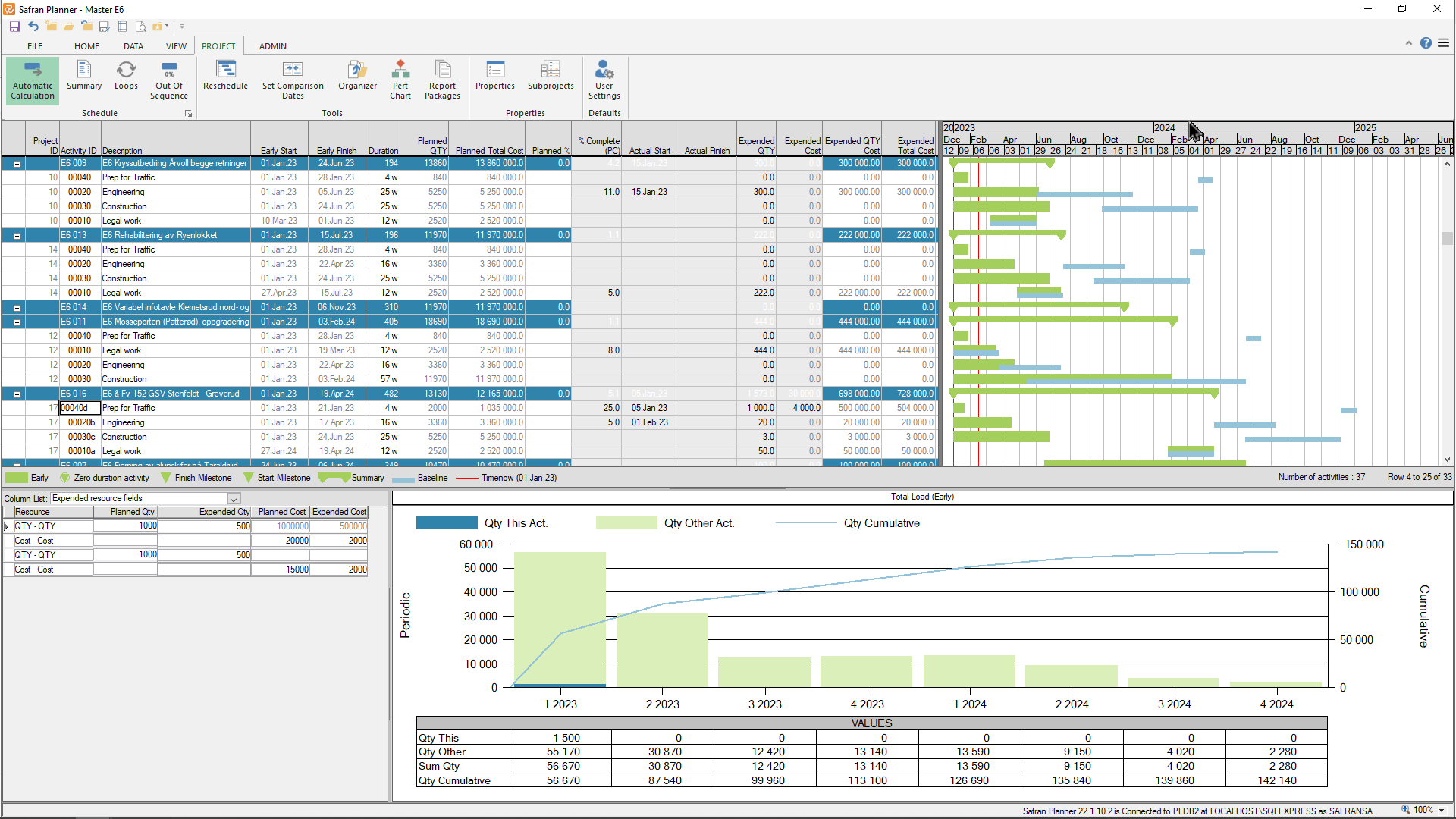
To see the fields Expended QTY and Expended Cost at the resource level, as seen above, you will need to define a column list including them.

Column lists may be defined by right-clicking on the resource information sub-panel's resource portion and selecting Column lists.

When the Resource Column List window opens, you are presented with a list of Available Fields. Select and drag the relevant expended fields to the right under Selected fields. The order in which the fields are given is determined by the order in which they are added to the selected fields panel.
When your list is complete, press the Save As button and give the list a name for easy reference. Finally, press OK to return to the resource information sub-panel.
If necessary, you may also nominate a user-defined column list as the default list for the resource information sub-panel by selecting a column list from the column list drop-down and pressing the Set default button.
Multiple resources
Suppose your project contains activities with multiple resources and you update Expended QTY/Cost at the activity level when the expended fields at the resource level are empty. In that case, the expended figures will be added to the first resource entered of each type (either QTY or Cost). The next time you update expended values, the new values will be added to the identical resource records.
If you update expended information at the resource level, it will be aggregated to the activity level. If you later switch to updating expended values at the activity level, Safran will distribute the aggregated figures to each resource according to the expended values present at that time.
Consider the following example:
An activity has two QTY-type resources, one with Expended QTY=1000 and the other with Expended QTY=2000.
If you then later update Expended QTY at the activity level to 6000, Safran will set Expended QTY for the first resource to 2000 and Expended QTY for the second resource to 4000.
Importing Progress & Expended
When working with multiple projects, it may be either impractical or irrelevant to import progress & expended information on a project-by-project basis for member projects in the group.
In the same way, as for single projects, Safran allows you to import this information from a file to one or more projects within the Project Group from a single import file.
Generally, when importing progress & expended information to projects within a Project Group, the field 'Net_id' should be included to ensure that the status information is transferred to the correct project/activity.
Your project's Net_Id may be found by selecting Project/Properties on the upper-left portion of the Details tab in the field ID shown below:

The correct 'Net_id' for multiple projects may also be found on the File/Open panel when you select As Master Project view in the ID column.

Alternatively, you could include the field Project ID in a barchart editor layout, which might be helpful when creating the basis for an Excel progress import worksheet.

Example of a Progress & Expended Import file qualified with 'Net_ID':

Including the field Net_id is, in fact, not mandatory, as Safran will produce error messages as part of its validation process if the same Activity ID exists in more than one project.

If your import file contains one or more non-ambiguous activity IDs, you will still be allowed to import this information; however, the ambiguous activity ID information will not be saved.
The Statistics from the saved progress and expended above show that 33 activity lines had errors, i.e., ambiguous Activity IDs due to not including the Net_id field to qualify the information. Four activities did have unique Activity IDs and were therefore saved/updated.
Status Updates
When working with a large number of projects in a Master Project, particularly in cases where some projects are complete/historical and not normally updated, entering each project and Setting Its Status can be time-consuming.
Safran Planner does not generally require that all projects be statused and updated to the current cut-off, and in many cases, this may not be relevant or necessary.
However, there are a few things to keep in mind. Some status-related indicators, such as the Cut-off date line in the Barchart, may be inaccurate.
Status information such as Progress %, Expended values, Current date sets, and frontline-related information will also be inaccurate for projects not statused to the latest Cut-off date.
When you open a project group containing projects with various/differing Timenow dates, the barchart editor will present each source project's Timenow in addition to the Timenow for the Project Group as illustrated below:

If a rescheduling process is carried out, the modified Timenow date for the Master Project will overwrite the Timenow date for each source project in the group. However, you will be given a warning that all subprojects will be updated and given the option to cancel the update.

When entering/modifying a Cut-off date in the master project as a basis for calculating the Frontline and presenting it, the date will be valid for the master project only. The Cut-off dates for the source projects will remain the same. If no Cut-off date is entered for the master project, presenting a Frontline will not be possible.
The Cutoff date may be entered/modified on the Project Properties panel shown below:


The cut-off date may also be found on the Frontline panel by right-clicking in the bar area of the barchart editor and selecting Frontline.

To carry out the status update process, you will need update access for each separate member project and to the master project itself.
Exporting/importing Master Projects
Exporting and importing projects is a practical way to back up/archive, make a copy or transfer project information between database environments.
When working in a Multi-Project environment with a large number of projects, it can be time-consuming and complicated to do this on a project-by-project basis. Additionally, if cross-project links exist, they would not be included in the export and would have to be entered manually after importing the projects.
Safran Planner's flexible processes allow you to export and import all or select projects from a master project in one operation. You may also specify a filter to select specific activities from your subprojects for export.
The Export and Import processes can transfer all project data except Enterprise fields to create an exact copy of your multi-project.
Exporting Master Project data
To export your master project, select File/Export from the ribbon or enter CTRL+E.

When the first Project Export panel opens, select 'Safran Project v20x' (the other options are unsupported for Project Group export) and press Next.
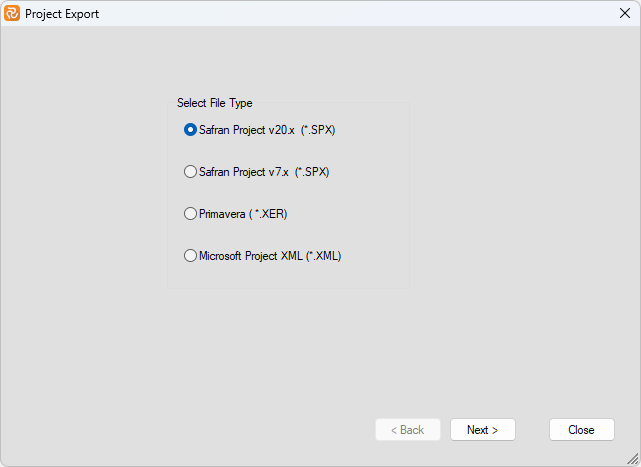
When the second Project Export panel appears, click 'Browse' to specify your export's destination folder and file name.
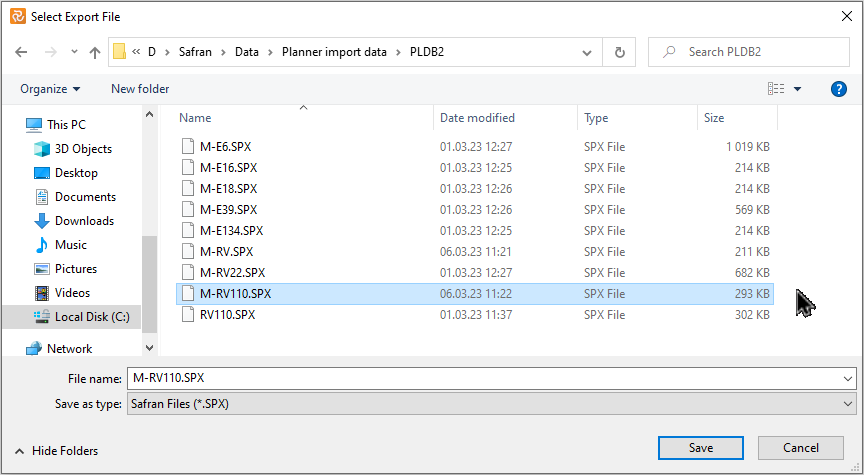
When you return from the Select Export File panel, select the 'With Subprojects' radio button below to see a list of your master projects.
Select the Master Project that you wish to export.

After you have set focus on/selected a master project for export, you can choose the Subprojects tab to get an overview of all the sub-projects in the group.
Note that by default, all projects will be exported. However, you may select subprojects by removing the 'Include' check for the relevant projects for your export.

Remember that you may also enter/apply a filter to include/exclude specific activities from your projects.
By default, the export file will contain all of the following Network related data:
- Activities
- Links
- Resources
- Calendars
- Cross Project Links
- QTY & Cost Expenditure.
However, you will be able to 'de-select' the export of Links, Resources, and QTY/Cost Expenditures if needed.
When satisfied with your Export configuration, press the 'Export' button to create the file.
When the export process is complete, an overview of the amount of data exported is presented.

Press Close to return to end the Export process.
Importing Master Project data
In addition to Safran's ability to export a complete or partial master project, you can also import a Master Project.
To import a master project, select File/Import Project from the ribbon menu.

Select your import file from the Select Import file window and press Open.

When you select and open a *.spx file that has been exported from a multi-project environment, Safran will detect that the file contains data from that environment.
You'll notice this when you open the file as the import panel is slightly different than that for the single project panel.

The Project Import window shows you a list of projects in the import file.
Unchecking one or more projects from the Sub-Projects panel allows you to choose which projects to import if all are not required.

The Data to Import sub-panel allows you to choose whether or not to import the following:
- Links
- Resources
- Resource Availabilities
- Cross-project links
Safran will, by default, save the project to the same Master Project name from which it was exported. If you change the project name in the Save As area, Safran will create a new master project.
If the default Master Project name exists in the Project's Database, the import will overwrite the existing Master Project.
Remember that you must have Update or Exclusive access to the Project Group and member projects to overwrite it. Additionally, you are not allowed to overwrite a Project Group if other users are accessing it.
You will also receive a warning message to ensure you want to proceed with the overwrite.

By default, Safran will open the Master Project when the import is complete. If you want to import without opening the resulting master project, un-check the 'Open imported project' at the bottom left of the Project Import window.
Best Practises
Synchronising Userfields in large-scale multi-project environments
In large-scale multi-contract projects, synchronising userfields will often be challenging as the various contractors and stakeholders have differing needs, resulting in differing userfields and configurations.
Each contractor will often have their own set of userfields and codes that, in many cases, do not have very much in common from contractor to contractor.
In addition, the project owner usually has userfields/codes to combine/aggregate project information and present a coherent, navigable picture of the project.
One way of approaching the challenge regarding Userfield definitions is to decide upon a split of the available userfields, i.e., one portion (R1-R30) of each field type (Reference, Outline, etc.) could be allocated to the project owner to suit the needs for structuring across the complete project, while the remaining portion (R31-R60) could be allocated to each contractor to suit each contract's requirements.
Then, a 'Master' userfield set containing the fields and codes, as defined by the project owner, is created.
Each separate contract will have its 'own' userfield set, in which the first/agreed-upon portion of fields inherits its definitions from the 'Master' userfield set.
Contractors would then have the fields/codes to populate their activities with the project owner's required fields/codes.
Each contractor would then be free to define and use the remaining fields to suit their internal contract requirements.
The project group definition would then select the 'Master' userfield set, allowing the project owner to structure the sort and selection of activities according to the overall project requirements.